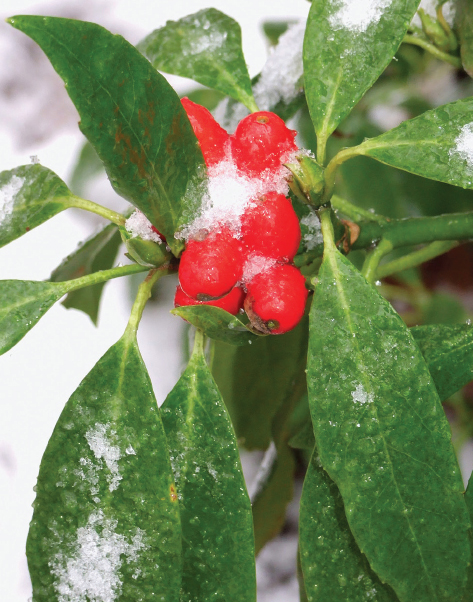Aucuba was introduced to Western gardens from the Far East in the late 18th century, and after 200 years-plus of reliable displays in American landscapes, opinions of this plant have tipped toward it being considered “ordinary.”
True, in some Cary neighborhoods you can’t throw a rock without hitting an aucuba bush, but this just shows how dependable many gardeners have found it to be.
And “dependable” doesn’t necessarily mean “dull.” Variegated forms are often called “gold dust plants” to reflect the many patterns of bright yellow flecks or streaks on their rich green foliage.
In addition, these glittering aucubas perform best in areas of the landscape most in need of interest: full to partially shady spots. Finally, being broadleaf evergreens, they faithfully shine on even the dullest of wintry days.
There are non-variegated aucubas, but while these all-green plants might predictably fade into the landscape during the summer, come early winter they serve up a holiday present.
 Aucubas are diodecious, meaning there are male and female plants. If both are located fairly close together, the females usually produce clusters of berries that ripen to a brilliant red right around the Yuletide season.
Aucubas are diodecious, meaning there are male and female plants. If both are located fairly close together, the females usually produce clusters of berries that ripen to a brilliant red right around the Yuletide season.
This makes these green-leaf aucubas with their merry crimson berries and delightfully deep emerald foliage as seasonally appealing as hollies or nandinas for fresh Christmas floral arrangements.
Aucubas are also confidence-builders for gardeners who think they are cursed with brown thumbs. These tough plants are drought tolerant — like hostas, they will do just fine in areas of dry shade typically found under stands of trees. And aucubas are ideal plants for city gardeners because these evergreens aren’t bothered by most urban pollutants.
There is, however, one important requirement for a happy aucuba: drainage. This plant can suffer from root rot in a watery environment. So, locate it in an area of well-worked soil not prone to turning into a bog when the rains come.
Depending on the cultivar, a regular aucuba — there are compact selections — can stretch upward of 5 to 10 feet, but spring prunings can hold this bush to a desirable size.
And keep your snippers handy in the summer, as this is a good time to propagate aucubas from cuttings. Take 6- to 8-inch-long tip prunings, dip the snipped ends into a rooting hormone powder and place the plants-to-be in pots of a sterile medium such as perlite or vermiculite.
This method works great, but if you want to keep it simple, just stick the cuttings into pots of average garden soil, place the containers in a shady location, water occasionally and see what happens. I have always had good results from this less-is-best method.
L.A. Jackson is the former editor of Carolina Gardener Magazine. Want to ask L.A. a question about your garden? Contact him by email at lajackson1@gmail.com.
To Do in the Garden
November
- Light frost on your Brussels sprouts, collards, kale or spinach? Good! A little icy dusting improves their taste.
- Be vigilant to keep newly-seeded fescue lawns clear of falling leaves. And also remember that a thick covering of leaves will easily mat down (especially when wet) and be detrimental to even established lawns. In other words, it is best to rake the yard several times in the autumn, not just once after the last leaf has fallen.
- Have a strange spring-flowering bulb but don’t know which end to plant up? Plant it sideways.
- Rake spent foliage, fallen blooms and summer mulch out of the rose bed, and replace with a fresh, 2- to 3-inch-thick winter mulch.
- Any gasoline left in motorized summer garden helpers such as lawn mowers and weed eaters should be used up or drained. Gas left in storage over an extended time can lose its fizz and gunk up carburetors.
- Consider adding accents that last year-round in the garden. Vases, statuary, fences, benches, walls, water fountains — these are constants that can help keep the garden interesting even in winter.
December
- A good substitute for lime is wood ash, so after the ashes of a wood fire have grown cold, sprinkle a light application on any garden beds that have high acidic concentrations (low pH).
- If you are adding mulch around trees, keep this organic ground cover at least 8 inches away from the trunks.
- Now is a good time to take hardwood cuttings of such deciduous woodies as forsythia, Japanese quince, mock orange, spirea and viburnum.
- Poinsettias will show off better through the Yuletide season if they are not placed close to vents that blow warm, dry air or doors that open to the outside cold.
- Remember your feathered friends this winter by regularly cleaning and refilling the birdbath and feeder. Also, on extremely cold days, remove ice from the birdbath and replace it with fresh water.
Timely Tip
 Ornamental peppers that transform into “Christmas peppers” at this time of year can display their festive fruits through the Yuletide season and well into the New Year if certain basic needs are met.
Ornamental peppers that transform into “Christmas peppers” at this time of year can display their festive fruits through the Yuletide season and well into the New Year if certain basic needs are met.
First, the pot should be free-draining, so remove any foil or plastic wrap. Water once a week, adding a weak fertilizer solution once a month and occasionally misting the leaves. Also, place the pepper plant in the sunniest indoor spot possible (four hours of direct sun or more is ideal) but at least 6 inches away from cold windows. As a side note, resist the temptation to eat the fruit; most ornamental peppers are poor, pithy, seedy cousins of typical tasty hot peppers from the summer garden.







